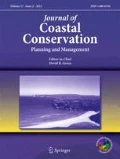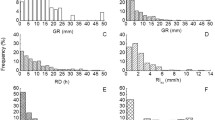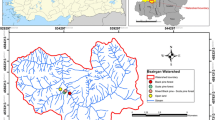Abstract
Fog water deposition may be an important component of the water budget of herbaceous-shrub ecosystems on the central and southern coastal regions of California. This paper presents the first analysis of measured fog water drip rates and meteorological controls in shrublands of Big Sur, California. Seasonal totals of 1255 mm and 306 mm of fog water drip were recorded in 2014 and 2015 (respectively), for averaged fog deposition rates of 0.02–0.08 l m2 hr.−1 to the soil under shrub canopy cover. The diurnal patterns of fog water drip showed that the majority of all trough water collected under shrubs on no-rain days occurred between the hours of 11 PM and 9 AM. During the study period from June 1 to October 31 of both 2014 and 2015, soil water content decreased significantly from average levels of 4–6 % at the shrub canopy center and middle locations, through 2–3 % VWC at the shrub edge locations, to levels at or below 2 % at 2-m distance locations from the shrub edge in open grass cover. Based on these results, we conclude that detectable rates of shrub canopy fog interception help sustain elevated soil water levels under shrubs and aid woody vegetation survival through periods of low rainfall.












Similar content being viewed by others
References
Azevedo J, Morgan DL (1974) Fog precipitation in coastal California forests. Ecology 55:1135–1141
Burgess SSO, Dawson TE (2004) The contribution of fog to the water relations of Sequoia sempervirens (D. Don): Foliar uptake and prevention of dehydration. Plant Cell Environ 27:1023–1034
Caceres L, Gomez-Silva B, Garro X, Rodrıguez V, Monardes V, McKay CP (2007) Relative humidity patterns and fog water precipitation in the Atacama Desert and biological implications. J Geophys Res 112:G04S14. doi:10.1029/2006JG000344
Castell C, Terradas J (1995) Atmospheric versus soil water deficit as leaf conductance regulator in Mediterranean trees: a correlational approach. Orsis 10:43–50
Corbin JD, Thomsen MA, Dawson TE, D’Antonio CM (2005) Summer water use by California coastal prairie grasses: fog, drought, and community composition. Oecologia 145:511–521
Da Silva PG, Bartolome JW (1984) Interaction between a shrub, Baccharis pilularis subsp. consanguinea (Asteraceae), and an annual grass, Bromus mollis (Poaceae), in coastal California. Madroño 31(2):93–101
De La Fuente L, Delage Y, Desjardins S, Macafee A, Pearson G, Ritchie H (2007) Can sea fog be inferred from operational GEM forecast fields? Pure Appl Geophys 164:1303–1325
Grace W, Ferriere P (2001) Statistical-empirical forecasting guidance for the occurrence of fog at Mount Gambier airport. Aust Meteorol Mag 50:15–27
Hanak E, Mount J, Chappelle C (2014) California’s Latest Drought, Public Policy Institute of California, Davis, California
Harr RD (1982) Fog drip in the bull run municipal watershed, oregon. Water Resour Bull 18:785–789
Henson P, Usner DJ (1993) The natural history of big Sur. University of California Press, Berkeley and Los Angeles
Hiatt C, Fernandez D, Potter C (2012) Measurements of fog water deposition on the California central coast. Atmos Clim Sci 2:525–531
Howitt RE, MacEwan D, Medellín-Azuara J, Lund JR, Sumner DA (2015) Economic analysis of the 2015 drought for California agriculture. University of California, Davis, CA, Center for Watershed Sciences, 16 pp
Ingraham NL, Matthews RA (1995) The importance of fog-drip water to vegetation, point Reyes Peninsula, California. J Hydrol 164:269–285
Joslin JD, Mueller SF, Wolfe MH (1990) Tests of models of cloudwater deposition to forest canopies using artificial and living collectors. Atmos Environ, Part A 24:3007–3019
Koračin D, Lewis J, Thompson WT, Dorman CE, Businger JA (2001) Transition of stratus into fog along the California coast: observations and modeling. J Atmos Sci 58:1714–1731
Leipper DF (1995) Fog forecasting objectively in the California coastal area using LIBS. Weather Forecast 10:741–762
Matzner SL, Rice KJ, Richards JH (2003) Patterns of stomatal conductance among blue oak (Quercus douglasii) size classes and populations: implications for seedling establishment. Tree Physiol 23:777–784
McBride JR, Heady HF (1968) Invasion of grassland by Baccharis pilularis DC. J Range Manag 21:106–108
McDermitt DK (1990) Sources of error in the estimation of stomatal conductance and transpiration from porometer data. Hortscience 25:1538–1548
Petterssen S (1938) On the causes and the forecasting of the California fog. Bull Am Meteorol Soc 19:49–55
Pilie RJ, Mack EJ, Rogers CW, Katz U, Kocmond WC (1979) The formation of marine fog and the development of fog stratus systems along the California coast. J Appl Meteorol 18:1275–1286
Potter CS (2014) Microclimate influences on vegetation water availability and net primary production in coastal ecosystems of Central California. Landsc Ecol. doi:10.1007/s10980-014-0002-6
Sawaske SR, Freyberg DL (2015) Fog, fog drip, and streamflow in the Santa Cruz Mountains of the California coast range. Ecohydrology 8:693–711
Stow D, Hamada Y, Coulter L, Anguelova Z (2008) Monitoring Shrubland habitat changes through object-based change identification with airborne multispectral imagery. Remote Sens Environ 112:1051–1061
Williams K, Hobbs RJ (1989) Control of shrub establishment by springtime soil water availability in an annual grassland. Oecologia 81:62–66
Acknowledgments
The author thanks the U.S. Forest Service for access to the Brazil Ranch property and for collaboration on climate-ecosystem science investigations in Big Sur. Cyrus Hiatt and Shuang Li of California State University Monterey Bay provided assistance with field measurements at Brazil Ranch.
Author information
Authors and Affiliations
Corresponding author
Rights and permissions
About this article
Cite this article
Potter, C. Measurements of fog water interception by shrubs on the California central coast. J Coast Conserv 20, 315–325 (2016). https://doi.org/10.1007/s11852-016-0443-y
Received:
Accepted:
Published:
Issue Date:
DOI: https://doi.org/10.1007/s11852-016-0443-y




